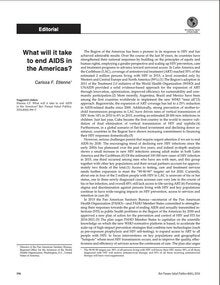The Region of the Americas has been a pioneer in its response to HIV and has achieved admirable results. Over the course of the last 30 years, its countries have strengthened their national responses by building on the principles of equity and human rights, employing a gender perspective and scaling up HIV prevention, care and treatment programs to advance toward universal access. In Latin America and the Caribbean (LAC), coverage of antiretroviral treatment (ART) reached 55% of the estimated 2 million persons living with HIV in 2015, a level exceeded only by Western and Central Europe and North America (59%). The Region’s adoption in 2011 of the Treatment 2.0 initiative of the World Health Organization (WHO) and UNAIDS provided a solid evidence-based approach for the expansion of ART through innovation, optimization, improved efficiency for sustainability and community participation. More recently, Argentina, Brazil and Mexico have been among the first countries worldwide to implement the new WHO “treat all” approach. Regionwide, the expansion of ART coverage has led to a 25% reduction in AIDS-related deaths since 2000. Additionally, strong prevention of mother-to-child transmission programs in LAC have driven rates of vertical transmission of HIV from 14% in 2010 to 8% in 2015, averting an estimated 28 000 new infections in children. Just last year, Cuba became the first country in the world to receive validation of dual elimination of vertical transmission of HIV and syphilis. Furthermore, in a global scenario of flat-lined investment and declining donor assistance, countries in the Region have shown increasing commitment to financing their HIV responses domestically...
|

